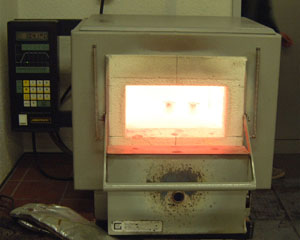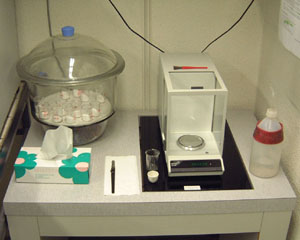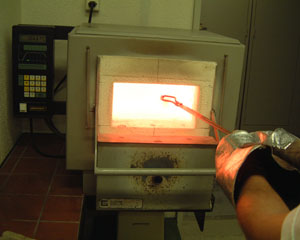Instructions for Users:
Loss On Ignition (L.O.I.)
Image may be NSFW.
Clik here to view.
Clik here to view.

- This is the oven (Muffeloffen) in which we heat the ceramic crucibles.
It is easily programmable (see text).
Note: Always wear a lab coat, safety goggles, and the appropriate gloves. Take Jewelery and watches off your hands, they conduct the heat very well. When you take the samples out of the oven, the metal heats up faster than your skin and that is where you get burns.
Scale:
Image may be NSFW.
Clik here to view.
The mass of the ceramic crucible has to be known empty,
together with raw sample, and after ignition
together with net sample mass (see text).
Clik here to view.

The mass of the ceramic crucible has to be known empty,
together with raw sample, and after ignition
together with net sample mass (see text).
For instructions on how to calibrate the scale if necessary, see "Glass Bead Powder Preparation".
Instructions:
Instructions:
Determining the Loss On Ignition (L.O.I.)
Material:
weighing:
Drying and using the oven
Let the sample drying in its open sample glass bottle in the hot-air cabinet for at least 6 hours (best overnight) at 105-110°C in order to remove remaining moisture (in earlier times called H2O-). The oven (Muffelofen) has to be pre-heated. On maximum heating rate, it takes about 2 h. If it is switched off, any temperature programming might be lost. Note that the display is in minutes. It is preferable to program it the night before, so that you can start using it right away once you arrive in the morning.
Sample amount
Weigh the empty ceramic crucible exactly and note the mass (n1) on the L.O.I. form. Slowly add the powder with the spatula and note the total mass (n2 = ceramic crucible + sample powder). No exactly mass of sample is necessary but to determine it with an accuracy of 0.1 mg (0.0001g).
Ignition
weighing:
- ceramic crucible (glass cupboard)
- powder spatula (drawer)
- dried sample powders in jars
- acetone, Kimwipes
- form „L.O.I.“ - download
- heated oven (Muffelofen)
- long tongs
- large leather gloves
- small Nomex® gloves (densely woven cotton)
- protection glasses with light filter
- fiber ceramic plate
- desiccator with blue drying agent (if it appears pink, it has to be placed into the drying oven for dehydration, in the large ceramic bowl)
Drying and using the oven
Let the sample drying in its open sample glass bottle in the hot-air cabinet for at least 6 hours (best overnight) at 105-110°C in order to remove remaining moisture (in earlier times called H2O-). The oven (Muffelofen) has to be pre-heated. On maximum heating rate, it takes about 2 h. If it is switched off, any temperature programming might be lost. Note that the display is in minutes. It is preferable to program it the night before, so that you can start using it right away once you arrive in the morning.
Sample amount
- 1.7 g sample powder for normal silicate rocks (L.O.I. of 1-10 wt.-%),
- 1.8 g sample powder for chlorite-rich or serpentinitic rocks (L.O.I. of 10-20 wt.-%),
- 2.3 g sample powder for carbonaceous rocks (L.O.I. of 30-50 wt.-%).
Weigh the empty ceramic crucible exactly and note the mass (n1) on the L.O.I. form. Slowly add the powder with the spatula and note the total mass (n2 = ceramic crucible + sample powder). No exactly mass of sample is necessary but to determine it with an accuracy of 0.1 mg (0.0001g).
Ignition
Image may be NSFW.
Clik here to view.![]()
Place the crucibles (numbered at bottom) into the oven and burn them red-hot at least 1 hour at 1050°C (1070°C if amphiboles >5%vol). Take the crucibles out and place them onto the fibre ceramic plate (at the Bunsen burner). After 5 minutes it is cold enough to handle it with a Nomex®-glove and place it into the desiccator. This protects your fingers and ensures that no skin fat or tissue is stuck to the crucible which would contribute to errors of the weighing result.
Weigh the crucible cold, always 10 minutes after removing it from the oven. Room temperature is reached in the crucible after ca. 5 minutes. If the crucible is still too hot, the air in the closed weighing chamber would be heated up, expanding and press on the scale. In experiments performed in this lab, it became obvious that the error due to adsorption of air moisture becomes negligible after 10 minutes. After 15 to 20 minutes though, recarbonatisation plays an increasingly significant role. Note its total mass (n3) and calculate the L.O.I. using this formula:
Formula for L.O.I. :
Calculate L.O.I.
Formula for L.O.I. :
L.O.I. (weight %) = 100 x ( (n2-n3) / (n2-n1) )
The L.O.I. is made of contributions from:
Volatile compounds :
H2O+, CO2, F, Cl, S; in parts also K, Na (if heated for too long);
Added compounds :
O2 (oxidation, e.g. FeO to Fe2O3), later CO2 (CaO to CaCO3).
NOTE: For later interpretation of the results of measurement:
Due to the escape of volatiles, there will be an increase of mass among all other oxides. By oxidizing FeO to Fe2O3, the value of Fe2O3total increases but all other oxides will be mass-reduced. These changes in concentration are considered in the calculation of the analysis data.
Rehomogenization
The burned off sample has to be rehomogenized in an agate mortar until the compound has a uniform colour. Depending on rock chemistry, at 1050° C and following cooling, a sintering, partial glass formation, or partial crystallization might occur. The grinding of the sinter optimizes the homogeneity and reduces the analytical errors.
Volatile compounds :
H2O+, CO2, F, Cl, S; in parts also K, Na (if heated for too long);
Added compounds :
O2 (oxidation, e.g. FeO to Fe2O3), later CO2 (CaO to CaCO3).
NOTE: For later interpretation of the results of measurement:
Due to the escape of volatiles, there will be an increase of mass among all other oxides. By oxidizing FeO to Fe2O3, the value of Fe2O3total increases but all other oxides will be mass-reduced. These changes in concentration are considered in the calculation of the analysis data.
